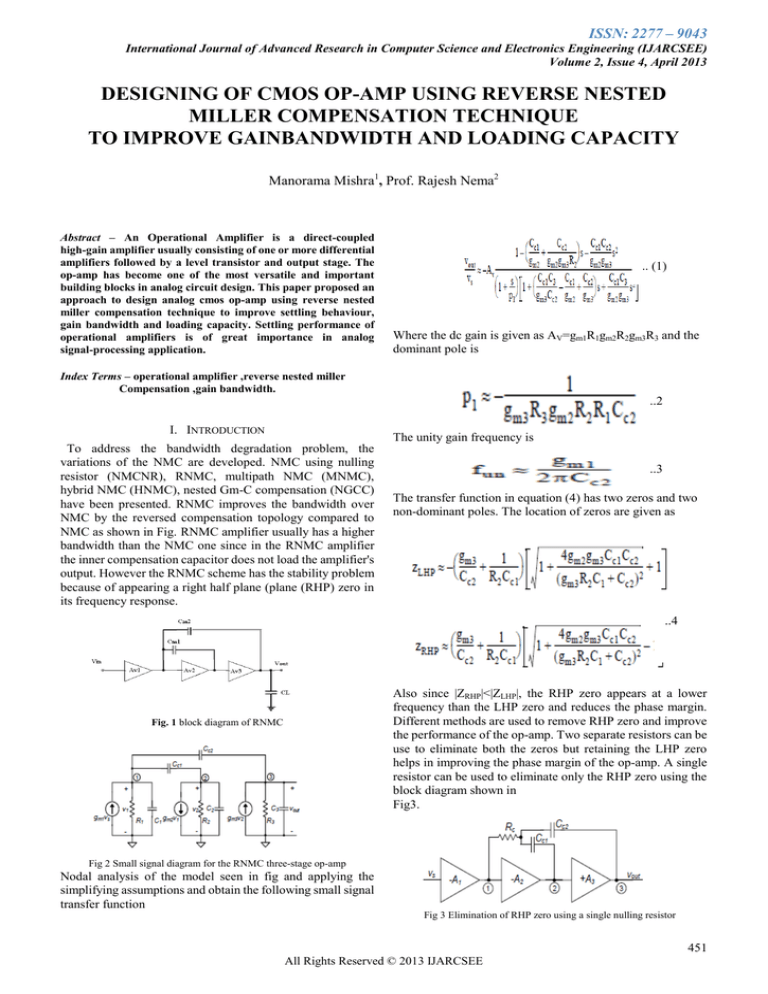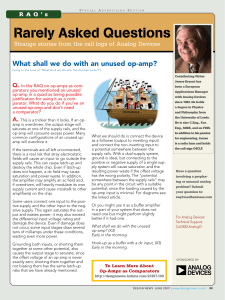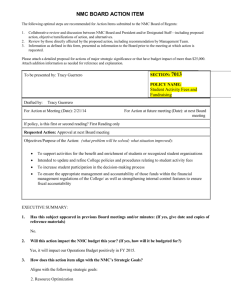
ISSN: 2277 – 9043
International Journal of Advanced Research in Computer Science and Electronics Engineering (IJARCSEE)
Volume 2, Issue 4, April 2013
DESIGNING OF CMOS OP-AMP USING REVERSE NESTED
MILLER COMPENSATION TECHNIQUE
TO IMPROVE GAINBANDWIDTH AND LOADING CAPACITY
Manorama Mishra1, Prof. Rajesh Nema2
Abstract – An Operational Amplifier is a direct-coupled
high-gain amplifier usually consisting of one or more differential
amplifiers followed by a level transistor and output stage. The
op-amp has become one of the most versatile and important
building blocks in analog circuit design. This paper proposed an
approach to design analog cmos op-amp using reverse nested
miller compensation technique to improve settling behaviour,
gain bandwidth and loading capacity. Settling performance of
operational amplifiers is of great importance in analog
signal-processing application.
.. (1)
Where the dc gain is given as AV=gm1R1gm2R2gm3R3 and the
dominant pole is
Index Terms – operational amplifier ,reverse nested miller
Compensation ,gain bandwidth.
..2
I. INTRODUCTION
The unity gain frequency is
To address the bandwidth degradation problem, the
variations of the NMC are developed. NMC using nulling
resistor (NMCNR), RNMC, multipath NMC (MNMC),
hybrid NMC (HNMC), nested Gm-C compensation (NGCC)
have been presented. RNMC improves the bandwidth over
NMC by the reversed compensation topology compared to
NMC as shown in Fig. RNMC amplifier usually has a higher
bandwidth than the NMC one since in the RNMC amplifier
the inner compensation capacitor does not load the amplifier's
output. However the RNMC scheme has the stability problem
because of appearing a right half plane (plane (RHP) zero in
its frequency response.
..3
The transfer function in equation (4) has two zeros and two
non-dominant poles. The location of zeros are given as
..4
Also since |ZRHP|<|ZLHP|, the RHP zero appears at a lower
frequency than the LHP zero and reduces the phase margin.
Different methods are used to remove RHP zero and improve
the performance of the op-amp. Two separate resistors can be
use to eliminate both the zeros but retaining the LHP zero
helps in improving the phase margin of the op-amp. A single
resistor can be used to eliminate only the RHP zero using the
block diagram shown in
Fig3.
Fig. 1 block diagram of RNMC
Fig 2 Small signal diagram for the RNMC three-stage op-amp
Nodal analysis of the model seen in fig and applying the
simplifying assumptions and obtain the following small signal
transfer function
Fig 3 Elimination of RHP zero using a single nulling resistor
451
All Rights Reserved © 2013 IJARCSEE
ISSN: 2277 – 9043
International Journal of Advanced Research in Computer Science and Electronics Engineering (IJARCSEE)
Volume 2, Issue 4, April 2013
II. PROPOSED MODEL
In This paper we are comparing RNMC with previous
techniques of op-amp designing and in previous techniques
NMC was the best technique ,that’s why we are comparing
RNMC and NMC. we proposed an approach to design analog
cmos op-amp using reverse nested miller compensation
technique to improve settling behaviour, gain bandwidth and
loading capacity. settling performance of operational
amplifiers is of great importance in analog signal-processing
application.
Objective of this work to analysis different two stages and
multistage cmos op-amp topologies, to handel the higher
value of capacitive load with optimum value of settling time
and power consumption. To Designing CMOS Op-amps with
fast settling time and low power consumption with higher
value of capacitive load is a very challenging problem.
Power consumption can be reduced by scaling the supply
voltage, but the dynamic range and speed also decreases. The
design of a high drive buffer has different constrains from
those of low power or general purpose Op-Amps. A high
drive buffer is needed to drive capacitive loads up to 1nF or
higher.
Settling time‖ is defined as the duration from an ideal step
input until the output of the amplifier enters and remains
within a specified error band related to the amplitude of the
pulse and the expected final settling value.
It can be separated into three parts:
(1) The delay
(2) The slew, and recovery and
(3) Linear settling.
In this analysis, AC signal is applied at the one input
terminal and another input terminal is ground, schematic of
the op-amp for AC analysis shown in figure 5. Simulation is
done by tanner tool and LT-spice. After simulation of
schematic of op-amp, net-list is generated. In this net-list
include 0.35µ technology file and 0.5μ technology file, input
signal and output print command. The output results gain and
phase plot is shown in figure 5.
In transient analysis, op-amp is used as voltage follower. One
input terminal connected to the output and pulse signal
applied to another terminal, shown in figure. Simulation is
done by tanner tool and LT-spice. After simulation, net-list is
generated. In this net-list include 0.35µ technology file and
0.5μ technology file, input signal and output print command.
Output waveform is shown in figure 6. Settling time is defined
as the time taken by the output to settle 98% of its final value.
Parameters
Ahuja
design
NMC
RNMC
Gain margin
90dB
100dB
72dB
Phase margin
70dB
70dB
80dB
Power consumption
37.92mW
2.16mW
178.5μW
Gain bandwidth
4.5Mhz
3.8Mhz
4.8Mhz
Settling time for 30pf
617,7n
888.35n
3.02u
Fig 5. Comparisons b/w different technique for different parameter
Fig 6. gain and phase plot of RNMC
Fig .4 Three stage op-amp with RNMC
III.
RESULT AND DISCUSSION
Different types of configurations are used to simulate the
Operational Amplifier. At the input of the Op-amp different
signals are applies to simulate and get the output results. In
the spice net-list model file of 0.35µ technology is to be
included.
452
All Rights Reserved © 2013 IJARCSEE
ISSN: 2277 – 9043
International Journal of Advanced Research in Computer Science and Electronics Engineering (IJARCSEE)
Volume 2, Issue 4, April 2013
[6] F. C. Nunes and J. E. Franca, ―Successive-approximation
tuning of monolithic continuous-time filters,‖ Electron. Lett.,
vol. 28, no. 18, pp.1696–1697, Aug. 1992.
[7] H. Yamazaki, K. Oishi, and K. Gotoh, ―An accurate center
frequency tuning-scheme for 450-kHz CMOS G � C
bandpass filter,‖ IEEE J. Solid-State Circuits, vol. 34, pp.
1691–1967, Dec. 1999.
[8] W. H. Press, S. A. Teukolsky, W. T. Vetterling, and B. P.
Flannery, Numerical Recipes in C. New York: Cambridge
Univ. Press, 1992.
[9] P. E. Allen and D. R. Holberg, CMOS Analog Circuit
Design. New York: Oxford Univ. Press, 1987.
[10] R. J. Baker, H. W. Li, and D. E. Boyce, CMOS Circuit
Design, Layout, and Simulation. Piscataway, NJ: IEEE Press,
1998.
Mishra1,
Department of Electronics &
Communication Engg,, M.Tech NRI Institute of Information
Science & Technology, Bhopal, India,
Manorama
Fig7. Step response of RNMC
IV. CONCLUSION
The NMC and RNMC amplifiers are simulated by
referring to a standard 0.35μm cmos technology. In NMC
typical load capacitance CL=30pf has been considered.
Settling time at the 30pf is 888.35n which is three times more
than conventional three stage op-amp and GBW is 3.8 MHz.
But as the load increases negative peaks are more as shown
figure .Power consumption will also increase as. We can use
NMC for high value of capacitive load but settling time and
power consumption will be more as compared to convention
three stage op-amps. RNMC improves the bandwidth over
NMC by the reversed compensation topology compared to
NMC.
Prof.
Rajesh
Nema2, Department of Electronics &
Engg,, H.O.D NRI Institute of Information
Communication
Science & Technology,
Bhopal, India,
After simulation it is concluded that RNMC is more stable for
high value of load capacitance than all other design and power
consumption is also reduced. But this two topology have more
settling time as compared to two stage op-amp with buffered
version.
REFERENCES-:
[1] Rosario Mita, Gaetano Palumbo and Salvatore Pennisi,
―Design Guidelines for Reversed Nested Miller
Compensation in Three-Stage Amplifiers,‖ IEEE
TRANSACTIONS ON CIRCUITS AND SYSTEMS—II:
ANALOG AND DIGITAL SIGNAL PROCESSING, VOL.
50, NO. 5, pp.227-233,MAY 2003..
[2] C. S. Park and R. Schaumann, ―Design of a 4-MHz analog
integrated CMOS transconductance-C bandpass filter,‖ IEEE
J. Solid-State Circuits,vol. 23, pp. 987–996, Aug. 1988.
[3] P. M. VanPeterghem and R. Song, ―Tuning strategies in
high-frequency integrated continuous-time filters,‖ IEEE
Trans. Circuits Syst., vol. 36,pp. 136–139, Jan. 1989.
[4] R. Sadkowski, ―Tuning monolithic continuous-time
leapfrog filter structures,‖Master thesis, Texas A&M Univ.,
Dallas, Dec. 1992.
[5] F. C. Nunes and J. E. Franca, ―Continuous-time leapfrog
filter with precise successive-approximation tuning,‖ in IEEE
Int. Symp. on Circuits and Systems, vol. 2, 1993, pp.
1271–1273.
453
All Rights Reserved © 2013 IJARCSEE







